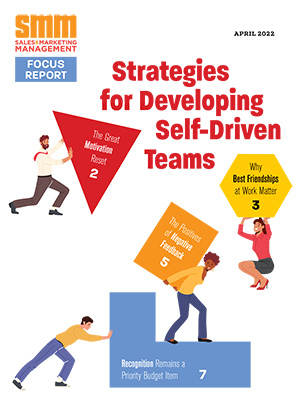Note: This is part 3 in a 3-part series on the powerful role sales management plays in driving sustained revenue growth – and how companies can better leverage this critical position for improved top-line performance.
Our first two articles in this series (1) established the compelling link between top-line revenue performance and frontline sales manager effectiveness, and (2) explored what “good” looks like in individual sales managers. In this article we explore the larger question CEOs and sales leaders must tackle: How do we create a high-performing sales management function that consistently drives superior top-line performance? While high-performing individual sales managers can move the revenue needle for a single team, a high-performing sales management function, in which every manager is consistently delivering excellent performance, can shift the revenue growth trajectory for the entire company.
This doesn’t happen by accident. High-performing, high-growth companies intentionally create an environment, a structure and an organization that methodically produces sales management excellence. They are rigorous in their focus on this role, understanding it is one of their most powerful drivers of sales results. In particular, high-growth companies do seven things to create a great sales management engine that drives sustainable, long-term growth.
1. Hire the right sales managers. Companies with consistently excellent sales management performance define a specific set of criteria around leadership, coaching, and other people management skills that they seek in candidates for sales management roles. They know what good sales management looks like and they have a program to vet candidates for those skill sets. So often, companies pour resources into understanding and hiring to the competencies for sales rep success but fail to bring the same level of introspection to the much more critical management role.
While the specific management competencies will vary from company to company, the bottom line is that managers must know how to manage. They must know how to motivate people and hold them accountable, how to coach and develop sales reps, how to structure territories and match them to a rep’s skill sets, and how to leverage data and use it to drive performance. This is a far different set of skills than those needed to become a top seller, which is why high-growth companies don’t automatically put their best reps into the management position to give them a career path upwards. Instead, they maintain a pipeline of great management candidates – which may or may not include some of their high performing sales reps. When an opening comes up, these companies know it is critical to fill the position with someone who meets the criteria proven to produce star managers, even if it means sourcing from the outside.
2. Establish a Company Way for sales management. In a typical company there are often as many different approaches to sales management as there are managers. Some lead by gut feel; others rely on metrics. Some help their reps close deals; others don’t. Some are constantly in the field; others lead largely from the office. But like any high-performing machine, sales management needs a structured, predictable set of inputs to produce the desired output. Companies must have a standardized “Way” for sales management. If everyone is left to manage as they wish, best practices cannot be replicated across the organization and overall results will suffer.
The best sales organizations create systematic, scalable management processes with well-defined cadences of activities that happen every week, month and quarter. They set clear objectives for manager-rep interactions, and they use a consistent set of leading indicators that drive the right activities. World-class companies codify these processes, cadences, and metrics in a sales management Playbook (the “Company Way” for sales management) that is used by all managers to produce consistently strong results. These organizations also equip sales managers with tools, such as cascading dashboards, that provide a quick snapshot of critical metrics in comparison to targets, that enable meaningful coaching interactions, and that facilitate the execution of required sales management activities.
3. Provide meaningful training. In our first article, we observed that when sales performance is below expectations, leadership tends to direct attention and training dollars on poor-performing sales reps, leaving managers to fend for themselves. Many companies assume that salespeople who are promoted to sales manager must somehow know how to manage other people (they have experience with being managed, after all) and that training them is unnecessary. And it is assumed that managers who came from outside must know what they’re doing, even though chances are very good that they never received any training at their former companies either!
Organizations with outstanding sales management capabilities develop robust training programs for their sales managers, including onboarding as well as initial and recurring training – not just on how to effectively manage salespeople, but on how to manage them the Company Way.
4. Implement a cadence of coaching and feedback for sales managers. Many sales leaders assume their development job is done once they bring good sales managers into the organization. That could not be further from the truth: front-line sales managers need coaching and feedback every bit as much as sales reps. Given the demands on the front-line manager role, focused coaching by sales leaders often makes the difference between adequate and superior performance. Many outstanding sales managers credit a former boss or mentor with helping them unlock their potential.
High-performing sales organizations require that sales leaders coach their front-line managers using a structured approach, consistently delivered at defined intervals. Coaching typically focuses on topics around core sales management skills – such as managing performance through metrics and coaching reps – and holding managers accountable for results. In addition, good coaching and feedback delivered by sales leaders helps reinforce the sales management training and the need to follow the Company Way.
5. Align sales targets across organizational layers. At top sales organizations, sales targets at each level of the organization are directly tied to the sum of the individual targets of a manager’s direct reports. For instance, if a sales manager is responsible for 10 sales reps, each of whom is charged with bringing in $1 million in sales, the manager’s target should be tied to the team’s $10 million objective. This continues up to the CSO, with every leader’s compensation tied to the performance of those they are responsible for, so that everyone is looking at the same goals and understands how their performance ties into organizational targets.
This approach seems obvious but many companies do not follow it, leading to surprises when overall sales results, without warning, do not meet expectations and it is unclear where accountability lies. Failure to ‘roll up’ targets leads to other problems as well. When sales managers’ targets are lower than those of their reps, it creates a disincentive for growth, reduces manager accountability and encourages retention of underperforming reps. When manager targets are higher than the aggregate rep quota, it reduces a manager’s ability to motivate their reps and typically results in missed targets.
6. Create incentives that drive the right behaviors. Too often, the compensation plan of sales managers does not align with the behaviors that the company would like to reinforce. For example, a manager’s bonus may be determined by overall growth while their reps’ compensation is tied to new logo sales. Or a manager’s incentive plan will pay out in full even though the team made goal only because one or two reps had an exceptional year while the rest of the team missed targets and were poorly managed.
High-performing sales organizations align objectives between rep and manager compensation plans and set aside a portion of compensation to reward managers who either demonstrate year-over-year improvement in each of their rep’s target attainment or achieve at least X% of quota across each of their rep’s territories. If the model is built correctly, managers will need to drive performance across the entire team to reach their own performance goals. This approach encourages sales managers to focus coaching time on reps with the greatest potential for improvement, rather than on top performers. It also motivates managers to take timely action in the event of persistent rep underperformance.
7. Foster a culture of accountability and replace underperforming sales managers. Just as high-performing sales managers communicate clear expectations to their reps, regularly measure their performance and hold them accountable, high-performing sales leaders must do the same for their managers. This is a fundamental expectation in high-performing sales cultures: sales leaders set expectations; give managers the tools, training and coaching to meet those expectations; then hold them accountable. Sales managers who can’t meet expectations are replaced.
The reality is that even with the best intentions, some sales managers will not have what it takes to drive their teams to excellence. Faced with disappointing performance, many sales leaders experiment with changes to roles, structure, territories, incentive compensation and talent rather than taking direct action. Often, they worry that firing a manager will cause a loss of customers and/or high performing reps. While this risk exists, it is often exaggerated, particularly when sales leaders are not sufficiently close to key customer decision makers and have little knowledge to objectively assess the risk. We have seen many companies where sales managers linger because they have longstanding relationships and everyone likes them – but their teams seldom make targets. That’s not okay. The sales management role is far too critical to keep an underperforming manager in it. Know who is and isn’t performing – and be ready to replace an underperformer with the pipeline of sales management talent you’ve been cultivating.
Sales organizations that embrace the seven dimensions of sales management excellence above drive sustainable, long-term growth. Is your organization there? If not, ask yourself and your leadership team what’s stopping your organization from institutionalizing a robust front-line sales management capability.
Brad Wilsted is a co-founder and senior managing director of Blue Ridge Partners, which provides management consulting services for mid-market and Fortune 500 companies. He has over 25 years of experience as a consultant and corporate executive and has advised over 150 companies across multiple industries on revenue growth strategy, pricing, customer segmentation, and sales and marketing effectiveness.


